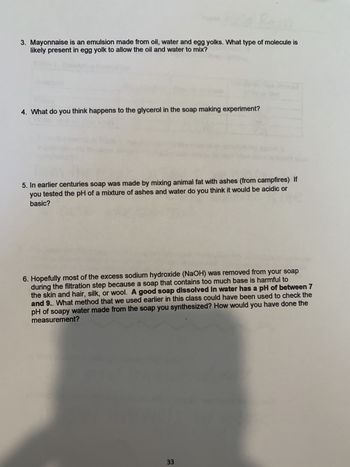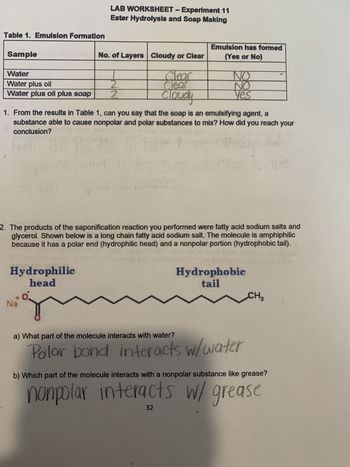
Chemistry
10th Edition
ISBN: 9781305957404
Author: Steven S. Zumdahl, Susan A. Zumdahl, Donald J. DeCoste
Publisher: Cengage Learning
expand_more
expand_more
format_list_bulleted
Question

Transcribed Image Text:3. Mayonnaise is an emulsion made from oil, water and egg yolks. What type of molecule is
likely present in egg yolk to allow the oil and water to mix?
4. What do you think happens to the glycerol in the soap making experiment?
5. In earlier centuries soap was made by mixing animal fat with ashes (from campfires) If
you tested the pH of a mixture of ashes and water do you think it would be acidic or
basic?
6. Hopefully most of the excess sodium hydroxide (NaOH) was removed from your soap
during the filtration step because a soap that contains too much base is harmful to
the skin and hair, silk, or wool. A good soap dissolved in water has a pH of between 7
and 9.. What method that we used earlier in this class could have been used to check the
pH of soapy water made from the soap you synthesized? How would you have done the
measurement?
33

Transcribed Image Text:Table 1. Emulsion Formation
Emulsion has formed
(Yes or No)
NO
es
1. From the results in Table 1, can you say that the soap is an emulsifying agent, a
substance able to cause nonpolar and polar substances to mix? How did you reach your
conclusion?
Fron
Sample
Water
Water plus oil
Water plus oil plus soap
Hydrophilic
head
LAB WORKSHEET- Experiment 11
Ester Hydrolysis and Soap Making
Na
0.
No. of Layers Cloudy or Clear
Clear
Clear
cloudy
2
2
water is t
2. The products of the saponification reaction you performed were fatty acid sodium salts and
glycerol. Shown below is a long chain fatty acid sodium salt. The molecule is amphiphilic
because it has a polar end (hydrophilic head) and a nonpolar portion (hydrophobic tail).
HO
Hydrophobic
tail
is able
a) What part of the molecule interacts with water?
Polar bond interacts w/water
CH3
b) Which part of the molecule interacts with a nonpolar substance like grease?
nonpolar interacts w/ grease
32
Expert Solution
This question has been solved!
Explore an expertly crafted, step-by-step solution for a thorough understanding of key concepts.
This is a popular solution
Trending nowThis is a popular solution!
Step by stepSolved in 3 steps

Knowledge Booster
Learn more about
Need a deep-dive on the concept behind this application? Look no further. Learn more about this topic, chemistry and related others by exploring similar questions and additional content below.Similar questions
- 2. Sodium nitrate has a lattice energy of -2.48 x 10² kJ/mol, and a heat of hydration of -234 kJ/mol. Determine how much heat is evolved or absorbed when 16.5 g of sodium nitrate completely dissolves in water?arrow_forwardA small unt of sodium bromide (NaBr) is dissolved in a large amount of water. Imagine separating this process into the four stages sketched below. (These sketches show only a portion of the substances, so you can see the density and distribution of atoms and molecules in them.) NaBr H,0 solution Use these sketches to answer the questions in the table below. The enthalpy of solution AH soln is negative when 0,0,... NaBr dissolves in water. Use this information to list the stages in order of increasing enthalpy.arrow_forward19. Use this solubility graph to answer the question below Solubility Graph 240 220 200 180 Key O Substance 1 • Substance 2 o Substance 3 A Substance 4 160 140 120 100 80 60 40 20 10 20 30 40 50 60 70 80 90100 Temperature (C) Which substances will form an unsaturated solution when a 60-gram sample of the substance is stirred into 100 g of water at 40°C? a. Substance 1 only b. Substance 4 only c. Substance 1 and 4 d. Substance 2 and 3 MacBook A Solubility (grams per 100 g of water)arrow_forward
- A 365 µM solution of a dye molecule, Rhodamine 6G, dissolved in methanol is allowed to sit open to the air such that the volume of the solution is reduced to 43% of its original volume due to evaporation of methanol. Assuming that no dye molecules are lost during the evaporation process, what is the concentration of the dye in the remaining ethanol after evaporation?arrow_forward1. What is the molality of a solution produced by dissolving !1.70 g of LiCI (42.39 g/mol) in water to make 0.115 L of solution with a density of 1.102 g/mL?arrow_forwardA saturated solution of a compound contains .15g of solute in 100 g of water. Is a second solution containing .05 g of solute dissolved in 25 g of water unsaturated, saturated, or supersaturated?arrow_forward
- Soap can differentiate between hard water and soft water. Which of the following will form a solid (scum) at the bottom of the container after shaking? O Nacl + soap + water NaCO3 + soap + water O CaCO3 + soap + waterarrow_forwardPotassium nitrate has a lattice energy of -163.8 kcal/mol and a heat of hydration of -155.5 kcal/mol. How much potassium nitrate has to dissolve in water to absorb 1.00 * 102 kJ of heat?arrow_forwardOf the following, which will increase the solubility of a gas in water? (a). increasing the temperature (c). increasing the volume (b). increasing the pressure (d). decreasing the pressure Kerosene is a non-polar solvent in which the solute will dissolve in: (a) hexane (c) ethanol (b) Sodium carbonate (d) Potassium chloride The solubility of a gas dissolved in a liquid is not affected by the: (a) nature of solute and solvent (c) temperature (b) rate at which the gas dissolves (d) pressurearrow_forward
- What is a saturated solution? O A solution that can't dissolve additional quantities of solute O A solution that can dissolve additional quantities of solute O A heterogeneous mixture O A diluted solutionarrow_forwardnone of these is correct Water and alcohol are two liquids. insoluble miscible immiscible surfactantarrow_forwardNitesharrow_forward
arrow_back_ios
SEE MORE QUESTIONS
arrow_forward_ios
Recommended textbooks for you
 ChemistryChemistryISBN:9781305957404Author:Steven S. Zumdahl, Susan A. Zumdahl, Donald J. DeCostePublisher:Cengage Learning
ChemistryChemistryISBN:9781305957404Author:Steven S. Zumdahl, Susan A. Zumdahl, Donald J. DeCostePublisher:Cengage Learning ChemistryChemistryISBN:9781259911156Author:Raymond Chang Dr., Jason Overby ProfessorPublisher:McGraw-Hill Education
ChemistryChemistryISBN:9781259911156Author:Raymond Chang Dr., Jason Overby ProfessorPublisher:McGraw-Hill Education Principles of Instrumental AnalysisChemistryISBN:9781305577213Author:Douglas A. Skoog, F. James Holler, Stanley R. CrouchPublisher:Cengage Learning
Principles of Instrumental AnalysisChemistryISBN:9781305577213Author:Douglas A. Skoog, F. James Holler, Stanley R. CrouchPublisher:Cengage Learning Organic ChemistryChemistryISBN:9780078021558Author:Janice Gorzynski Smith Dr.Publisher:McGraw-Hill Education
Organic ChemistryChemistryISBN:9780078021558Author:Janice Gorzynski Smith Dr.Publisher:McGraw-Hill Education Chemistry: Principles and ReactionsChemistryISBN:9781305079373Author:William L. Masterton, Cecile N. HurleyPublisher:Cengage Learning
Chemistry: Principles and ReactionsChemistryISBN:9781305079373Author:William L. Masterton, Cecile N. HurleyPublisher:Cengage Learning Elementary Principles of Chemical Processes, Bind...ChemistryISBN:9781118431221Author:Richard M. Felder, Ronald W. Rousseau, Lisa G. BullardPublisher:WILEY
Elementary Principles of Chemical Processes, Bind...ChemistryISBN:9781118431221Author:Richard M. Felder, Ronald W. Rousseau, Lisa G. BullardPublisher:WILEY

Chemistry
Chemistry
ISBN:9781305957404
Author:Steven S. Zumdahl, Susan A. Zumdahl, Donald J. DeCoste
Publisher:Cengage Learning

Chemistry
Chemistry
ISBN:9781259911156
Author:Raymond Chang Dr., Jason Overby Professor
Publisher:McGraw-Hill Education

Principles of Instrumental Analysis
Chemistry
ISBN:9781305577213
Author:Douglas A. Skoog, F. James Holler, Stanley R. Crouch
Publisher:Cengage Learning

Organic Chemistry
Chemistry
ISBN:9780078021558
Author:Janice Gorzynski Smith Dr.
Publisher:McGraw-Hill Education

Chemistry: Principles and Reactions
Chemistry
ISBN:9781305079373
Author:William L. Masterton, Cecile N. Hurley
Publisher:Cengage Learning

Elementary Principles of Chemical Processes, Bind...
Chemistry
ISBN:9781118431221
Author:Richard M. Felder, Ronald W. Rousseau, Lisa G. Bullard
Publisher:WILEY